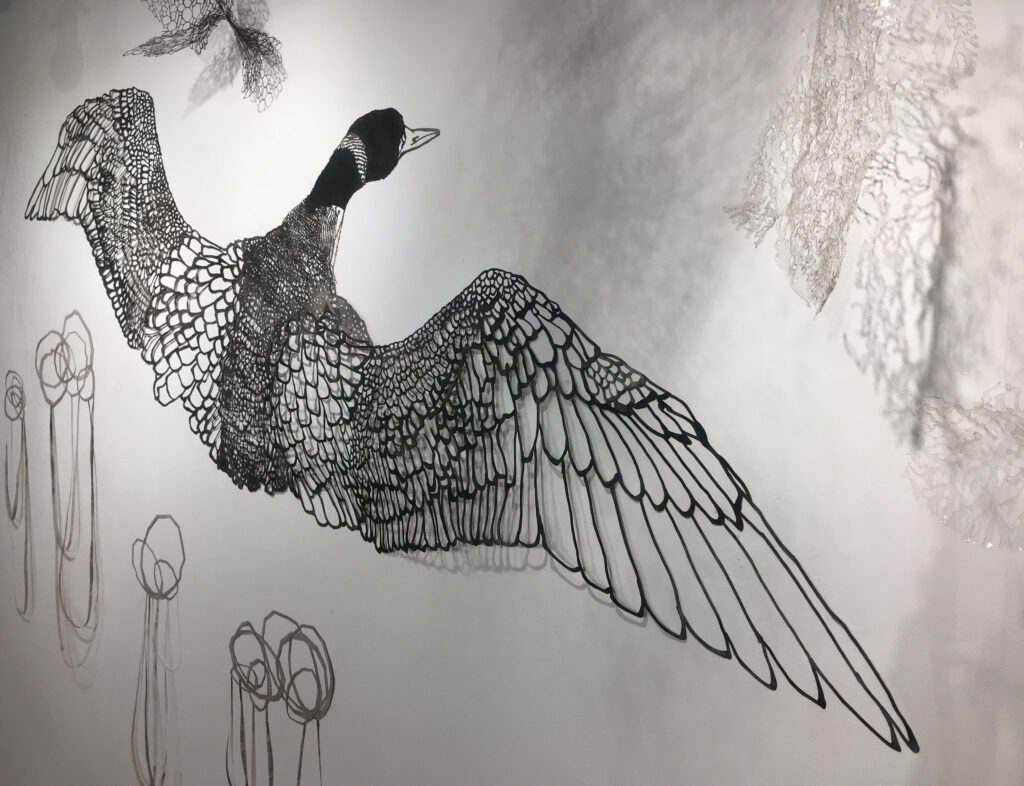
Meg Moriarty is no stranger to balancing a variety of fields. Having a background in cinema production and screenwriting, her practice is wide-ranging — spanning sculpture, photography, video, installation, illustration, and education.
When Moriarty’s not managing the Root Division wood shop and digital lab for studio artists, teaching classes, or working on her master’s degree at San Jose State University, she’s hard at work in the second year of Root Division’s studio program, investigating the intersections of cosmology, spirituality, alchemy, and micrology.
Recently, Exhibitions Fellow, Sherwin Rio visited Moriarty in her studio to talk about her multifaceted artistic trajectory, the bridging of symbols, memory, and history in her work, and her solo exhibition Flight Between in the Frank-Ratchye Project Space during the month of November.
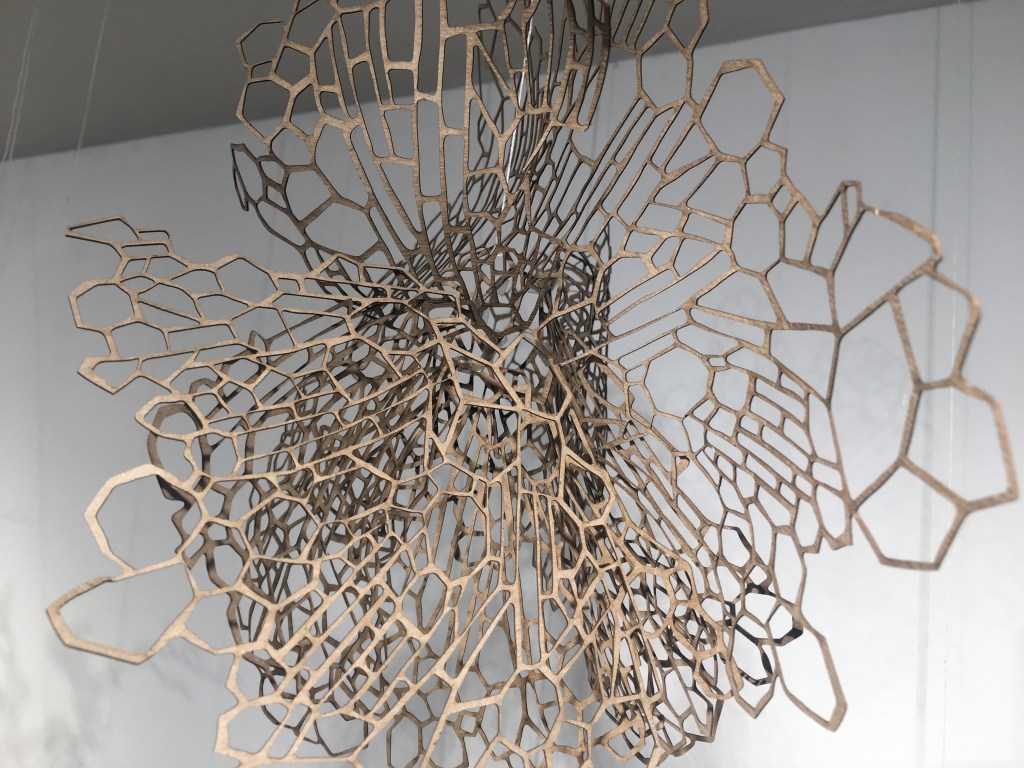
Sherwin Rio (Exhibitions Fellow): Meg, firstly– thank you so much for making time to have me here to ask you a few questions and to share your studio with me.
Meg Moriarty: Oh yeah, no problem!
SR: Looking around your studio, I see that you’re constantly working on many very different projects at one time. I can’t help but compare it to a big multi-part production…Do you find that the blending of mediums or the interdisciplinary nature of your process has always been a way that you work?
MM: I’ve always been that person! When I got my associate’s degree in filmmaking and screenwriting, I always had something going on. When you’re on set there’s something always in development and a film project can take years! So you always have to be working on more than one thing.
I was always making small sculptures as gifts for people that weren’t pertinent to that person at all or making really elaborate halloween costumes]! People at school started to pick up on it and they asked me to be the art director for their projects. When I finished that program, I actually learned how to edit 16mm film on old editing machines and that film element is still a big part of what I do because I love the material so much.
When I started looking for jobs in the industry, I was so disappointed. I decided to become an art director. When I went and took sculpture classes after that, my sister who’s also an artist was like “Duh, you’re supposed to go make sculptures! Look at what you’ve already been doing!” And I just kept going with it.
Eventually, everyone told me that if I wanted to be an artist, I needed to know how to teach what I’m doing, and so I started doing that too.
SR: How much does being an educator play a role in your art-making and vice versa?
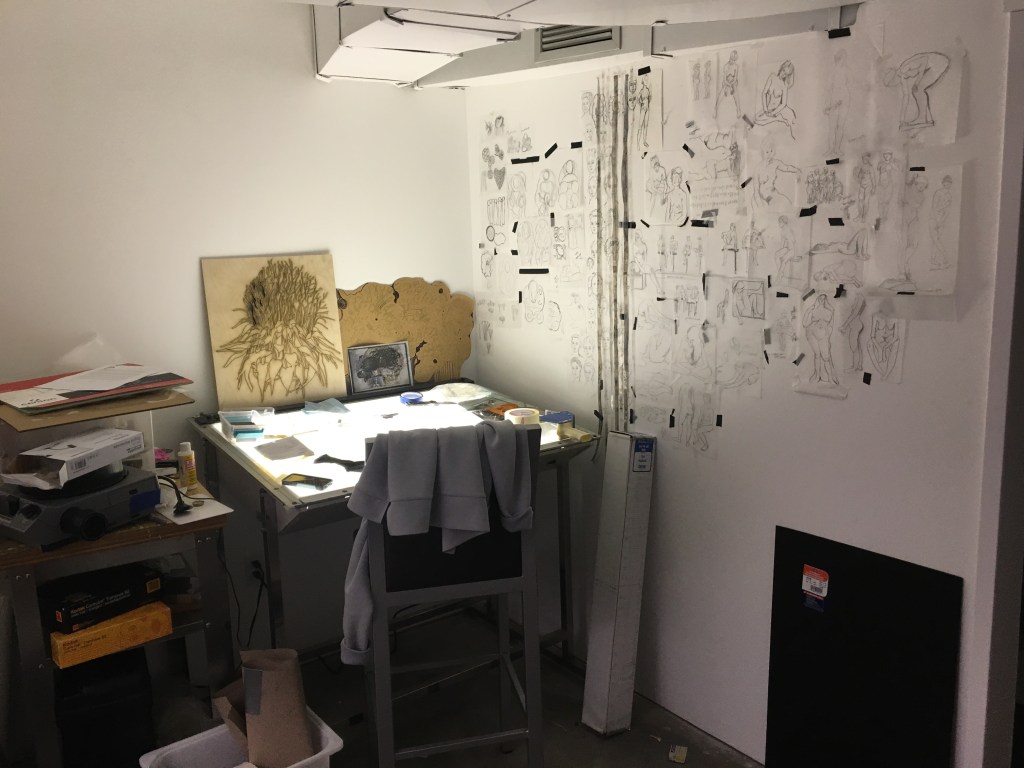
MM: Teaching makes me consider what’s going on in contemporary art. I have to always be looking at what’s contemporary to bring lessons in and make things meaningful for my students. It keeps me fresh in that way. But it also makes me think about how digital tools are going to be the future of how sculptors make things.
A majority of my students at San Jose State University are digital media students and they each make me excited about things that I never thought about before. For example, as a result of trying to show them how digital can meet the 3D world, I learned how to laser cut and now that’s about everything that I do. Finding those meeting places between traditional fine arts and new technology coming out is very important to me.
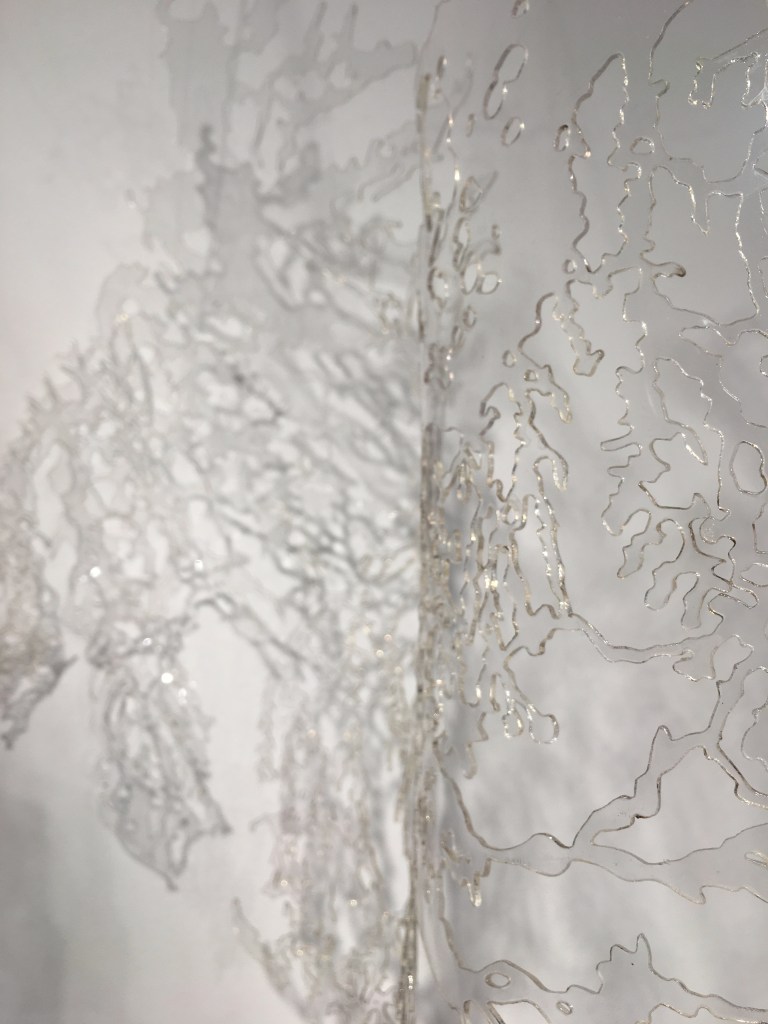
SR: Do you find that– as you’re teaching digital process more and more– it’s more difficult to continue working in the analog? …
MM: Not at all! I play with both because I find that material is super important. I also don’t necessarily follow the rules of digital.
SR: Yeah in your work it seems that it’s never just digital, it’s digital inspired by the analog or…
MM: Yeah I’m using archaic machinery instead of “up-to-date” machinery, so my slideshows use old carousels that I find on eBay and all my slides are recycled and purchased in bulk online. Also with my drawings that I take to laser cut, I always try to re-incorporate actual drawing material. For example, I apply conte crayon to the the loon drawing after it’s cut. It’s really important to me to blend time and material. We need that bridge.
SR: Speaking of bridging, synthesizing, and combining, can you speak to the idea of the artist as alchemist? How do you start tackling such a large topic like alchemy in your work? Also themes in your work like spirituality, cosmology, and micro-science?
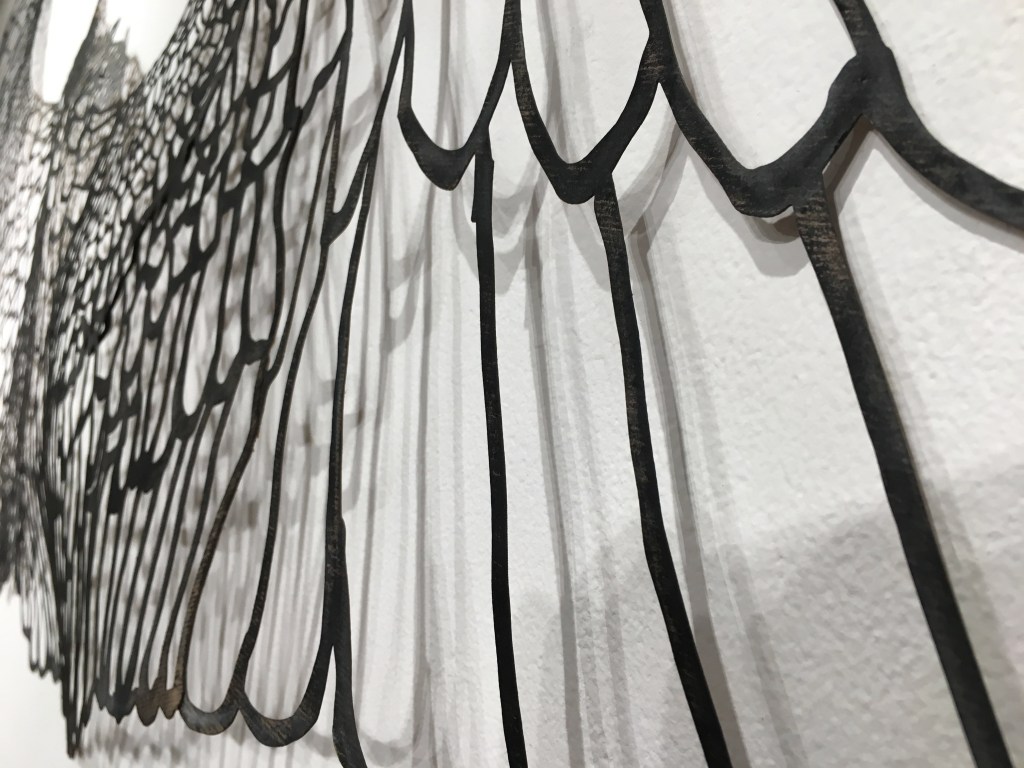
MM: As I kid I wanted to be a nun so that I could work in a cloistered nunnery and do arts and crafts, so there was always a sort of spiritual element. I was raised super Catholic and it permeated the work I was doing. I knew a lot about ritual, and the more time I spent in that world and the more educated I became, the more I understood how ritual crossed religions especially when you study art. Art can be applied as a tool for many religions. It’s more of a tool than something on its own.
Simultaneously, the more educated I became, the harder it was for me to believe in the religious aspect of it. I became more interested in human nature toward spirituality and having to address science, the intellectual, and time. I had a wonderful glass instructor who gave us an alchemy assignment and I just fell in love with it! Alchemy applies these magical lines of thinking and so I try to apply those magical lines of thinking.
SR: When you’re doing research for your projects, how does that research often look like?
MM: I follow my instincts about a symbol I really enjoy and then I’ll expand on it. I have a whole series called Lithic Bursts that are geometric designs based on plant cells and how they fit.
Or I’ll take things I find in my slide paintings and I’ll expand on them and draw them out. Those things become really fractal and beautiful on their own. And then I’ll also look for ways that we in society symbolize death and birth, something seemingly two-sided. Right now I’m working on the loon as a symbol. The loon is this endangered bird that I grew up with. It lives in Minnesota when it’s breeding and then it flies to the coast the rest of the year but it has different plumage so you can’t see it on the coast. I’m playing around with this idea of flying in-between and death.
SR: Can you expand a bit more about intangible experiences of memory and the visual translations of memory? This process of translating memory to visuality?
MM: I find all the neurological research into what our brains look like, while we’re doing certain things really fascinating. Researchers are looking for ways to make memory tangible in that way and the way that we think tangibly. As an artist, I’m really fortunate to explore that in the physical realm, how do I make things physical and how can I deal with memories physically?
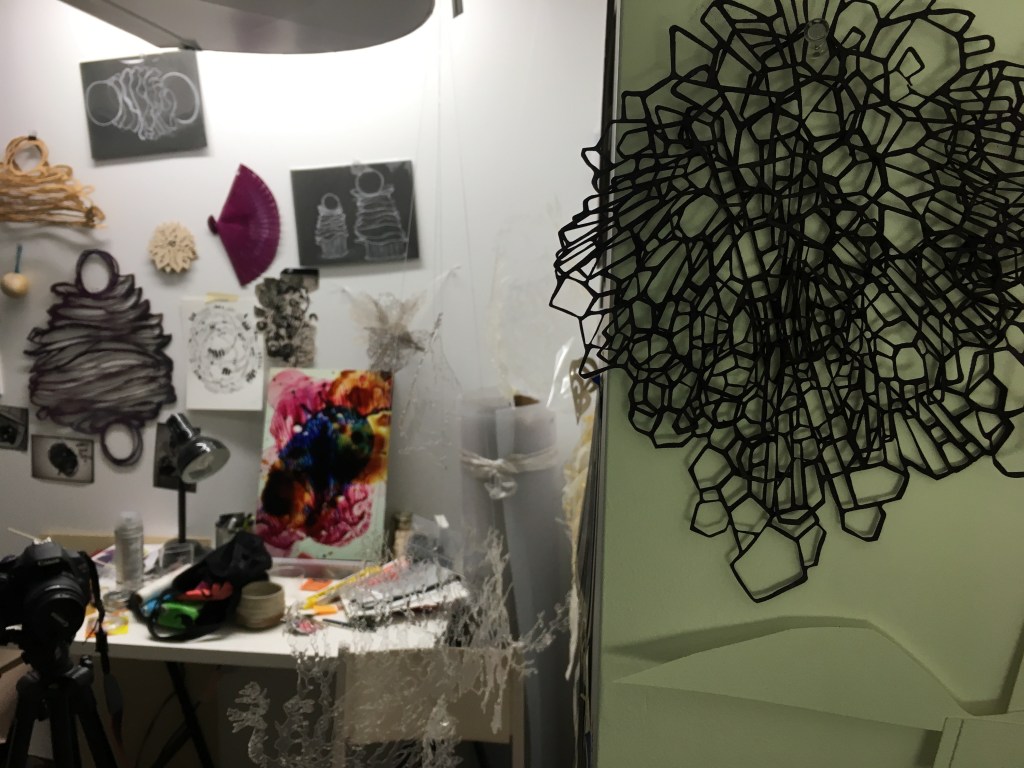
SR: How long have you been in Root Division and what are your roles here?
MM: I’ve been here about a little over a year now! I’m the on-call shop technician, so I make sure everything’s running smoothly in the wood shop and digital lab for our artists. I also teach classes. I’ve taught Canvas-Making, Acrylic 101, and Cardboard Sculpture. Cardboard is an amazing material to sculpt with because you don’t have to be precious with it!
SR: Has your work developed in a certain way during your time as a studio artist here?
MM: I embraced flatness. That was a huge tension in my work before I got here to Root Division. I knew that it was something that I wanted to explore and so I wanted to create something that was flat but also in the round that could be in space. That’s something that I’ve been doing a lot of work to think through here.
SR: Lastly, do you have any upcoming projects/exhibitions/etc. that you’d like to share with us?
MM: I will be in the San Jose State University 2019 MFA Lift Off Exhibition in San Francisco this Spring. I am also currently making arrangements for a creative project in Ireland that would look at pre-Celtic monuments as a meeting place to discover a relationship between landscape, technology, and spirituality.
